|
 Hygrophorus involutus Hygrophorus involutus
BiostatusPresent in region - Indigenous. Endemic
Images (click to enlarge)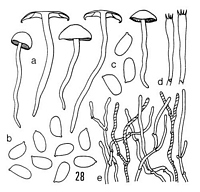
Caption: Hygrophorus involutus Stev.: a. carpophores. - b. spores. - c. spores (type). - d. basidia. - e. cuticle (Herb. HK. ZT 68/6501 | 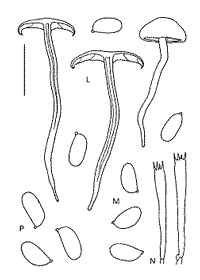
Caption: Fig. 40 Hygrophorus involutus Stev. (L-M: ZT 68/650): L. basidiomes.
M. spores. N. basidia (K 1347, type): P. spores. | 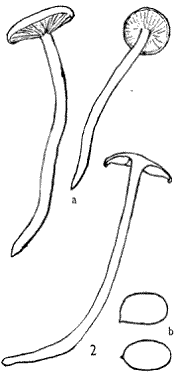
Caption: 2a, H. involutus,
X I; 2b. spores, X l000. | 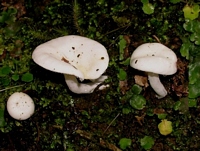
Caption: FUNNZ photo
Owner: J.A. Cooper | 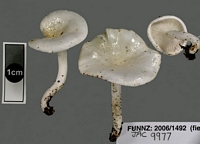
Caption: FUNNZ photo
Owner: J.A. Cooper | 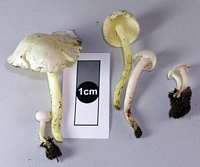
Owner: J.A. Cooper | 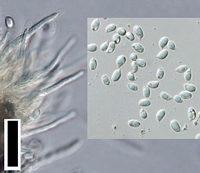
Caption: caulocystidia and spores. Scale = 20um
Owner: J.A. Cooper | 
Caption: ZT68-650
Owner: E. Horak: © Creative Commons Attribution-Noncommercial 3.0 New Zealand | |
Article: Horak, E. (1990). Monograph of the New Zealand Hygrophoraceae (Agaricales). New Zealand Journal of Botany 28(3): 255-306 (http://www.rsnz.org/publish/abstracts.php).
Description: Pileus-30 mm, hemispherical becoming convex to plane or subdepressed at disc,
papilla absent, margin strongly inrolled in young basidiomes; white turning
pale yellow or apricot; glutinous, margin not translucently striate, not hygrophanous,
glabrous to innately fibrillose in dry conditions. - Lamellae 12- 18 (1-5) crowded,
broadly adnate to subdecurrent pale yellow to wax-yellow or apricot, edges concolorous,
entire. - Stipe 40-65 x 2-3 mm, cylindrical, mostly tapering towards base, rooting,
often caespitose, rarely single; white to pale yellow; slimy, apex densely covered
with glutinous, yellowish guttation droplets becoming pruinose or velutinous
at dry condition, fistulose, very brittle. Context white to pale yellow, fragile.
- Odour and taste not distinctive. - Chemical reactions on pileus: KOH - orange.
Spores 5-7 x 3-3.5 um, ellipsoid. - Basidia 30- 40 x 4-6 um, 4-spored. - Cystidia
absent -Pileipellis an ixocutis of cylindrical, erect to intertangled hyphae
(2-5 um diam.), membranes strongly gelatinised, with yellow plasmatic pigment;
clamp connections present (Pl. 1, Fig. 7).
Habitat: ECOLOGY: Common; saprobic on soil among litter in broadleaved-conifer forests
(Brachyglottis, Nothofagus, Leptospermum, Weinmannia, Phyllocladus, Cyathea).
June-July.
Distribution: DISTRIBUTION: NZ (NA, SA, G, W).
Notes: Hygrophorus involutus is the most common of all New Zealand Hygrophori.
The distinctive characters of this species are the strongly inrolled margin
of the pileus, the tapering stipe, the conspicuous slimy drops at the upper
portion of the stipe and the fragility of the basidiomes. In addition this taxon
is also microscopically well distinguished by rather small spores of slender
elliptical to subcylindrical shape.
Article: Stevenson, G. (1963) [1962]. The Agaricales of New Zealand: IV. Kew Bulletin 16(3): 373–384.
Description: Pileus 1-2.5 cm. diam., white, glutinous,
plane with a strongly downrolled margin exceeding
the gills, pellicle felt-like, peeling; flesh whitish, water-soaked, yielding
drops of clear fluid when cut. Gills adnate, moderately
thick, moderately crowded, shallow, with a pale pink tinge. Stipe 4-6 X 0.2-0.3 cm., white, upper part velutinate,
lower part more or less peronate, cottony striate set with drops of gluten, solid, continuous with
cap, equal or tapering at rooting base. Spores 6-7 X 4 µm, oblong, thin-walled,
hyaline, print white. Basidia
30-35 X 3-5μm, four-spored.
Habitat:
habitat: terrestrial, rooting in soil
or among litter under forest and scrub, Keith George Park, Wellington, 15.6.1949 ; Day's Bay, Wellington, 7.6.1952; Butterfly, 2.6.1958;
all Stevenson.
Article: Horak, E. (1973). Fungi Agaricini Novazelandiae I-V. Beihefte zur Nova Hedwigia 43: 200 p.
Description: Pileus 10-30 mm diam., hemispherical becoming convex to plane, rarely subdepressed at the centre, margin strongly inrolled, white, turning yellowish, glutinous, neither hygrophanous nor striated. Lamellae broadly adnate to subdecurrent, yellowish to wax yellow, crowded, gill edge concolorous, even. Stipe 40-65 x 2-3 mm, tapering towards the base, rooting, single or fasciculate, whitish-yellowish, apically densely covered with glutinous drops being pruinose or velutinous in dry conditions, slimy towards the base, fistulose, very fragile and brittle. Context whitish-yellowish. Odor and taste not distinctive. Chemical reactions on pileus: KOH - orange.
Spores 5-7.5 x 3-3.5 µm, ellipsoid, smooth, inamyloid. Basidia 30-38 x 4-5 µm, 4-spored. Cystidia absent. Cuticle consisting of erect, cylindric or subclavate hyphae forming a palisade, membrane strongly gelatinized, yellow plasmatic pigment present. Clamp connections present.
Habitat: In soil under broad leaved trees (Weinmannia, Elaeocarpus), Phyllocladus, Brachyglottis, tree-ferns (Cyathea, Dicksonia), etc. New Zealand.
Notes: The most distinctive characters of this species are the strongly enrolled margin of the pileus, the tapering stipe, the slimy drops at the upper portion of the stipe and the fragility of the carpophores. For more detailed discussion see H. salmonipes Stev. (29).
|